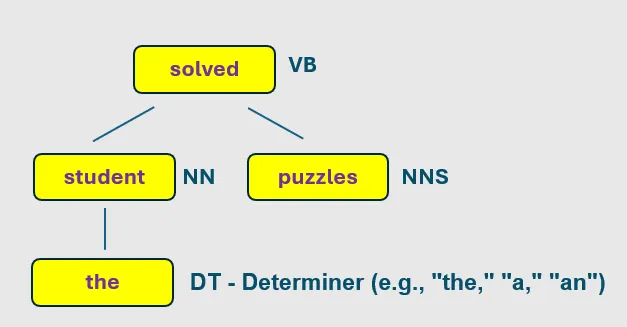If syntactic analysis provides us with the building blocks, dependency parsing shows us how those blocks interact.
What Is Dependency Parsing?
At its core, dependency parsing is about discovering who’s doing what to whom. Every word in a sentence depends on another word, creating a web of connections that form a dependency tree. This tree doesn’t just describe the parts of a sentence but shows how they relate.
Continuing with the previous example, “ The students solved puzzles”.

The arrows indicate the dependencies, showing that the students are the subjects acting “solving” and the puzzles are the objects of this action.
Root : Solved
Dependent:
- students (depends on
solvedas subject) - the (depends on
studentsas determiner) - puzzles (depends on
solvedas object)
Every word in a sentence, apart from the root verb, depends on another word. These dependencies allow the sentence to form a coherent structure.
Applications of Dependency Parsing
Dependency parsing is invaluable in many NLP tasks, particularly those that require a deep understanding of sentence structure.
1. Coreference Resolution
In complex texts, identifying which nouns pronouns refer to can be tricky. Dependency parsing helps track dependencies between words across sentences, making it easier to resolve coreferences. e.g.,
John said he would call her later,
A dependency parser can identify that he refers to John, helping resolve the coreference, which is vital for tasks like text summarization or machine translation.
2. Question Answering Systems
In question-answering tasks, dependency parsing helps by identifying the critical relationships between words in both the question and the source text. e.g., when answering:
Who directed the movie Inception?
Dependency parsing shows that directed is the head verb, and Inception is the object, helping the system focus on extracting the relevant answer, Christopher Nolan.
3. Fine-Grained Semantic Role Labeling
Dependency parsing aids in identifying the semantic roles of words in a sentence. In the sentence:
The teacher assigned homework to the students,
A dependency parser clarifies that teacher is the agent (the one acting), assigned is the action, and students are the recipients of the action. This detailed understanding is crucial for applications like information extraction and semantic search.
Recommended Reading:
For a practical exploration of different tools used in dependency parsing, check out this article on Towards Data Science:
Dependency parsing is essential for uncovering the intricate relationships between words in a sentence. We gain deeper insights into sentence structure by analyzing these dependencies, which enhances various NLP applications.